#sustainable permaculture
Text

LOOKlooklooklooklook LOG GARDEN BEDS!!!!
Rotting logs hold moisture like a sponge so it would keep the conditions moist for your plants, It would provide fertilizer to them and ideal conditions for symbiotic fungus, it creates the perfect habitat for useful beneficial creatures, and it could be used on an eroded area to make a barrier against erosion.
If a tree ever falls down in a storm or has to be cut down for whatever reason this is an excellent idea to consider. You could even raise the log off the ground to allow for trailing vines or place things underneath
880 notes
·
View notes
Text
The Permaculture Spiral Garden - A Great Starting Point
There is probably no other structure as popular for illustrating Permaculture in practice as the Herb Spiral. Okay, I guess I could mention the lasagna sheetmulching method or also the cob oven that tends to be the first hands-on project at a typical Permie intro session. But when it comes to showing how landscape design, zones and sectors, stacking functions, and efficient use of space and water come together in one unique structure, the Spiral Garden is unbeatable.

Turning Theory into Practice
In typical Permaculture Designer Certificate courses, but even in brief intro weekends to Permaculture, there tends to be a lot of theoretical discussions. Since the numerous design principles can be applied to any climatic region, from the tropical to the subarctic, and on any scale from the humongous to the tiny, the practical aspects of the ideas can easily get lost. That's where a good hands-on application comes, where the participants get to move around rocks and dirt, while realizing how much it ties in to the concepts they've just discussed. This way the apparent "main purpose" of "building something to grow all your kitchen herbs on", becomes a neat side feature.

Adjust Your Landscape!
The first thing to realize that landscape is welcome to be modified and adjusted to bring out the best in it. Clearly, while it is important to work with what's there already, it doesn't hurt think about mounds and valleys. And before you bring out the excavators for your large-scale farm, it makes sense to start small… say on a circle of 2-5 meters (6-16 feet) diameter. In other words, the Spiral Garden is a hill with a spiral shaped surface, leading down to ground level, or further down into a water hole. It can be made out of rocks, bricks, concrete debris, or anything else you have lying around that can hold your soil.

Design According to Your Scale
Looking around for existing Herb Spirals it's easy to get confused. Some are so big you can actually climb on them (that is, you have to in order to reach what's growing on top). Others are so tiny that you may not even want to step on them. The question is: which size is the right one for you? Since this is something you will have to decide almost daily in Permaculture, it doesn't hurt starting out with this important question.
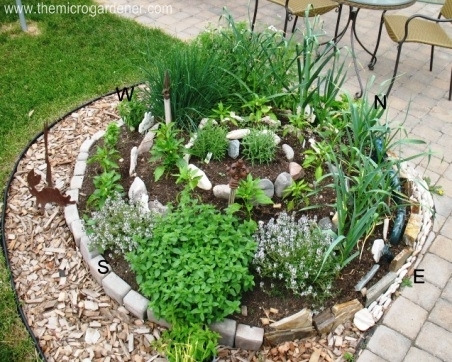
Organizing Your Spiral Garden
While there are seemingly endless types of Spiral Gardens, there are a few things they all have in common: They all start out with a region on the top, where water is bound to run off right away, leaving the soil relatively dry. This area is also the most exposed to the wind. Keep this in mind when choosing the plants that are going to live here. Ideally, the spiral should start sloping toward the East from here. Delicate plants that benefit greatly from the morning sun will appreciate this region. As the slope continues toward the South and West, it becomes more suitable for sun loving species. Finally, as the spiral reaches the ground level in the shady Northern part, it will be perfect for herbs that prefer less sun, more shade and more water, since the soil tends to be wetter here. (Note: This is for the Northern Hemisphere. In the Southern Hemisphere North and South are reversed.) To make full use of the runoff water, many people add a small pond at the base of the spiral, where additional aquatic plants, such as watercress, can be grown.

The given illustration offers a good number of herbs for a nicely diverse kitchen. Depending on what else you want in your Herb Spiral, you can add it in the most suitable region. Mint and lemon balm love the cooler, shady part with more water. Lemongrass is great in the sunny area, and tarragon and estragon prefer the dry top of the spiral. Of course, the idea is not limited to kitchen herbs. For maximalists, the same theory can work with a mountain you might want to terraform into a spiral farm. But right now I'd prefer to stay small scale.
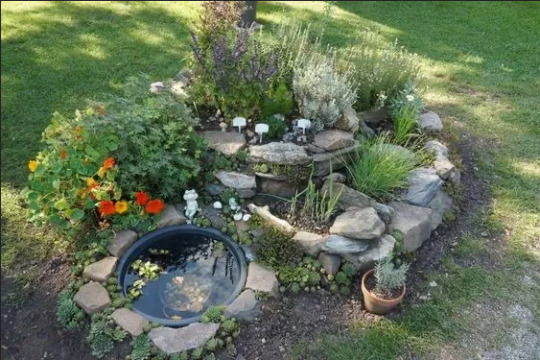
Plenty of Benefits (That's Why It's Permaculture)
As explained above, the main purpose of the Spiral Garden is not only to increase your gardening area by making use of the vertical, but also to create diverse climatic conditions, which do make a difference on the smallest scale. But as Permaculture tends to be, there are many other benefits to it. The structure itself offers great habitat for numerous animals, such as frogs, salamanders, lizards, but also pollinating insects, and of course others that may not directly benefit us, but by feeding on others they all add to the stability of our ecosystem. The structure itself will suppress weeds and make use of material that you're not likely to use elsewhere. Finally, depending on the size and location, it will be an ideal place to grow all your kitchen herbs right where you can access them most easily.

Some Things to Keep in Mind
When building the structure, make sure it will contain the soil in a nice trough, slanting slightly inward. That way bits and pieces that fall off will roll towards the center, until contained by the main mound.
Make sure the slope is always nice and gradual, avoiding sudden drops where the water can rush down quickly, eroding the soil.
If you're going to walk on your spiral, include a separate walkway that won't compress good soil. Most importantly, it should be sturdy enough to provide stability and make access safe.
Don't forget that while the structure is important to keep the soil in place, it is the soil that you'll be growing plants in. So it should have a good depth of 20-50 cm (8-20 inches) throughout the entire spiral. This can be the trickiest part!
Apply your own observation to which plants do better in which parts of the spiral. Also, with time you will find many other plants growing in it that you didn't plant. Before removing them, consider how much they actually bother your herbs, and whether their benefits may not outweigh their drawbacks.
Go Out and Build Your Own!
I hope this brief overview got you inspired to go out and try building an Herb Spiral yourself! I would love to hear your experiences with it!
Sources: 1, 2, 3, 4
3K notes
·
View notes
Video
youtube
How to turn your Neighborhood into a Village
Permaculture instructor Andrew Millison journeys to Portland, Oregon to talk with architect Mark Lakeman, founder of Communitecture Architecture and the City Repair Project. Mark initiated a movement in Portland to transform the homogenous neighborhoods of the city into places that have many of the qualities and characteristics that are found in some of the most treasured villages on Earth. Mark reveals the things you need to know to transform your own neighborhood into a village.
Previously on Solarpunks:
Ideas & Inspiration For Better Cities: Sprawl Repair
Retrosuburbia
#solarpunk#neighbourhood#sprawl#repair#regenerative#urbanism#portland#andrew millison#permaculture#retrosuburbia#suburbia#US#design#Sustainable Design#community
1K notes
·
View notes
Text
Hey, hey, don't cry. Plants fruiting and flowering, okay? The earth is laughing and exhaling and taking up space, right?




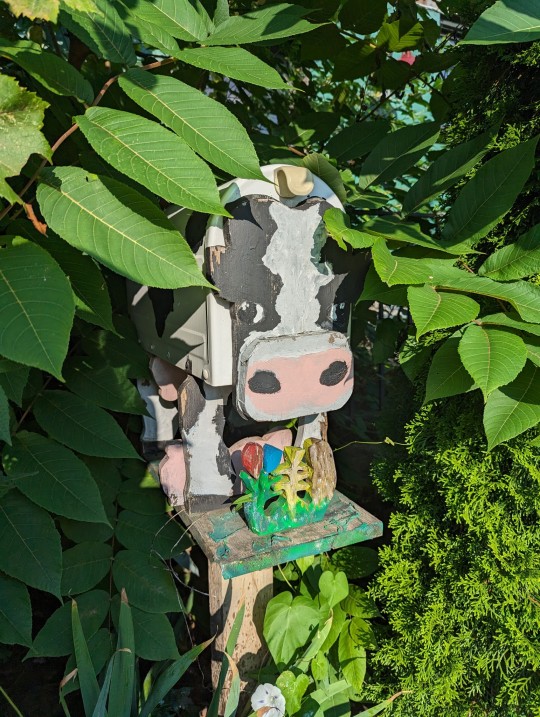

550 notes
·
View notes
Text

from the 'wholistic + abundant {lifestyle}' Pinterest board
#g#infographic#earth stewardship#permaculture#holistic leveling up#leveling up#slow living#soft living#solarpunk#that girl#green juice girl#wellness journey#true being#true nourishment#mindful consumption#ethical consumption#mindfulness#sustainability#eco conscious#ecofeminism#sidewalkchemistry
379 notes
·
View notes
Text
#permaculture#city planning#solarpunk#renewableenergy#renewables#sustainability#green future#green infrastructure#green technology#functional supply chains
58 notes
·
View notes
Text
Permaculture Garden In The High Desert
youtube
this guy is in the high desert of colorado. soil conditions there are slightly different than here in so cal. we have high alkalinity here & so need to add nutrients differently to balance the soil. otherwise everything hes saying here applies to our operation.
this guy has solid advice. chiefly, save your own seed & invest that time! adapting plants to your environment & putting in the work are absolutely key to success in self sufficiency. and of course, build that soil by composting everything you can.
in the 10 years we've been working this land, I've watched the soil in my garden plots transform entirely. every year i am encouraged by the visible progress. every year i ramp up my efforts.
love what this guy's doing. i hope he gets to "retire" soon so he can go full time on his farm.
#permaculture#gardening#sustainable living#self sufficiency#high desert#old timers & their wisdom#Youtube
48 notes
·
View notes
Text
How to blend art with climate action.
I wanted to show you all something really cool.
So there's this re-wilding group I am a part of called Long Lands Common. About 30 acres of land was collectively bought to be turned into a wild area and the project has inspired further re-wilding efforts all around the area.
For part of the Annual General Meeting, we had a discussion about how we could incorporate art into the AGM gallery event. So along with displays showing all the progress LLC has made so far since its inception about 2 years ago, we put up a huge piece of paper for people to draw a forest on and populate it with magical creatures.

This art piece is symbolic of how collective action has helped us to create a forest. The magical creatures represent all of the animals we don't know about that need protecting, and they were also included to help encourage people's creative side since creativity and joy are the keys to tackling the climate crisis.
If you want to help do something about the climate crisis, I highly recommend getting involved in your local re-wilding or permaculture project. It is the best way to deal with the climate crisis on a local level while also re-building our communities that have been broken apart by Capitalism. These projects are also very disability-inclusive. I am autistic and there are several physically disabled members who tend to the lands as well. We have all been treated extremely well and made to feel included.
And to any artists out there - especially those who have become jaded because of AI art - I hope this shows you all how important real, human art is in building a Solarpunk future.
#rewilding#ecology#biodiversity#permaculture#solarpunk#solarpunk art#sustainability#environmentalism#climate change
121 notes
·
View notes
Text

Currently Reading
Dave Jacke with Eric Toensmeier
EDIBLE FOREST GARDENS
VOL 2 - DESIGN & PRACTICE
Ecological Vision and Theory for Temperate Climate Permaculture
#Dave Jacke#Eric Toensmeier#farm life#farming#food forest#forest garden#permaculture#reading#sustainability
114 notes
·
View notes
Text
How to collect & use kitchen grey water to conserve water and water your garden all at once!
1. Soap* up/scrub your dishes:

2. Put a big pot in your sink:

3. Start rinsing your dishes:

4. Mmmm, dirty dish water**:

5. Let cool a bit if you used very hot water, then water plants of your choice***:

Do look up the grey water regulations in your area, at least so you know them. Read up a bit more on greywater systems. This may or may not be legal in your area, but understanding why it is or isn't can help you decide how to safely incorporate water reuse into your life.
One of the common big ones is that your not allowed to just let the water sit there, or pool on the ground. A common tactic is to divert the water below the surface of the soil, which can be accomplished easily. Some people don't want you to use kitchen grey water because of concerns around bacterial contamination from raw meat, etc, so consider how you're going to deal with that.
* don't use chlorine or borax (I don't know anyone who does for dishes, but you can't be sure on the internet). If you're quite concerned about your soap, get one that's labeled environmentally friendly or whatever.
** I'm a vegan so I don't have to worry about this, but if you're not, make sure you don't use waste water from dishes that had contact with raw meat or eggs. Because of potential bacterial contamination.
*** soap is basic, so don't water acid-loving plants with this. Never allow the water to pool for any length of time. Here you can see that I'm watering a cucurbit, which are thirsty plants that appreciate extra nutrients.
#solarpunk#practical solarpunk#solarpunk gardening#permaculture#greywater#graywater#the punk is because this isn't technically legal#but they also didn't make a law here specifically targeting this method#;)#water conservation#sustainable vegan#vegan gardening#vegan solarpunk
740 notes
·
View notes
Text


June garden update
Omg, so many things have changed since May, but I try to do my best to summarize:
- Planted tomatoes, paprikas, eggplants and cucubers. They are looking pretty good now!
- Created a raised bed, I used the hugelkultur method

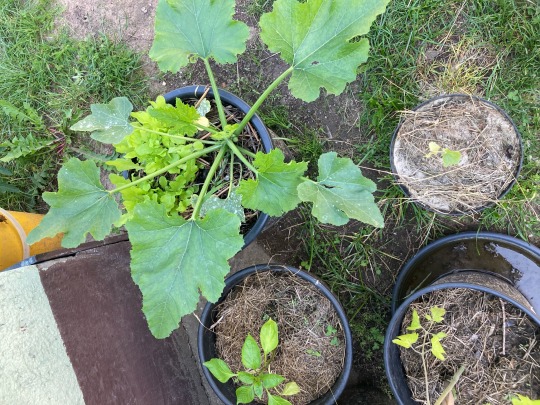
- Lettuce, tomatoes, zucchinis, and sunflowers are getting HUGE
- Ruccola is not growing very well, I might have to find a less sunny spot for them
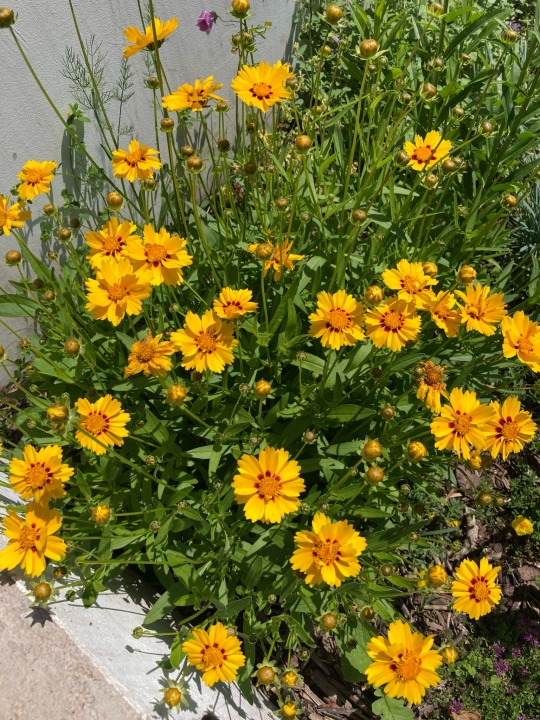

- Coreopsis just started blooming
- I got hooked on growing microgreens, I will post a separate little article about it later


#solarpunk#gardening#garden#sustainability#permaculture#garden update#vegetables#container gardening#growing food#balconygarden#raised beds#self sufficiency
72 notes
·
View notes
Quote
Solarpunk without the abolition of capitalism is just greenwashed Cyberpunk.
#solarpunk#solar punk#sustainability#sustainable#climate science#climate activism#climate disaster#climate collapse#climate change#global warming#permaculture#windpower#solar panels#greenwashing#greenway#green new deal
687 notes
·
View notes
Text
Closing Loops in Soilless Gardening - Hydroponics and Aquaponics
What is the future of food production going to look like? Is the projected 10 billion people in 25 years, out of which two thirds will live in cities, going to require us to convert every square meter of arable land into intensive mono cultural farms? Please don't let that be true! There HAS to be some alternative. Fortunately, there are several. Two of them are different ways of growing plants without soil, a radically new method, which may be most appealing to urban food production.

image source
Hydroponics: Growing Plants in Water
When it comes to growing large amounts of food on a small area efficiently, hydroponic systems are often brought up as a solution. And the reasons sound pretty convincing: An efficient hydroponic farm uses 90% less water, and can yield 3-10 times the amount of produce per area, with 7-14 growth cycles in a year. IMPRESSIVE! But before getting too excited, let's not forget: the devil is in the details! It's worth looking into under exactly what conditions those plants grow, being fed by what light, and most importantly which nutrients, and where they come from.
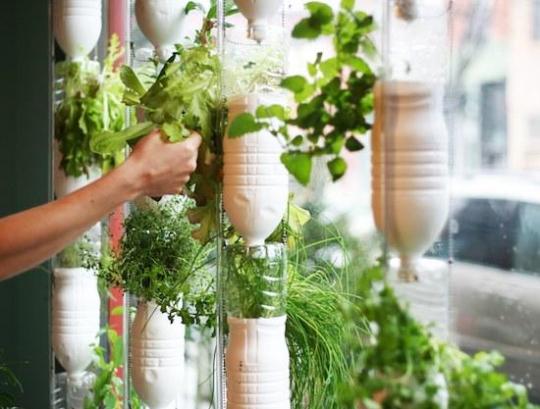
image source
The basic concept, however, of growing plants vertically, in mostly water, with some kind of substrate, such as clay balls or vermiculite, is actually a pretty nifty way to grow food where there are no fields. The most basic form of this may be the Windowfarm technique, which I experimented with myself years ago in my Budapest apartment. Going to Shanghai, the whole idea seems to be taken to a whole new level.
https://static.dezeen.com/uploads/2017/04/sunqiao-urban-agricultural-district-Sasaki-architecture-industrial-china-shanghai_dezeen_hero-b.jpg
image source
Is That Really Sustainable? Or Even Healthy?
… not to mention, does hydroponics even fit into Permaculture? Because let's be honest: with a system that needs to be constantly managed and monitored you could not be further from a self-supporting ecosystem. Also, what exactly do those plants get to eat? The typical N-P-K made industrially out of petrochemicals? Most likely. So while it certainly reduces the transport related drawbacks, hydroponics is by no means energy efficient, and the nutritional value won't be any better than your most industrially grown veggies.

image source
How Does Aquaponics Compare?
Okay, so let's bring in the fish! For those not familiar with the difference between the two systems, aquaponics is the combination of hydroponics and aquaculture, which are simply fish farms. Having fish in a tank, they will naturally defecate into the water, requiring it to be changed regularly. Plants, however love to eat those nutrients that the fish excrete. Or to be more exact, they feed on the nutrients that have been converted by bacteria and other microbes. The ammonia will turn in to nitrites, which in turn become nitrates, that is food for the plants.
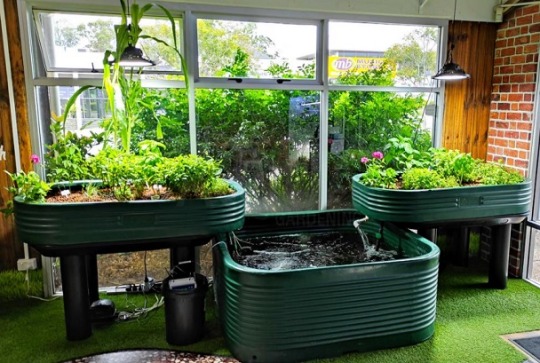
image source
So running the water from the fish through the plants growing substrate will on one hand feed the plants, as well as clean it for the fish to enjoy it again. So the system already closed a few loops there, making it more sustainable than just mere hydroponics. Also, the inclusion of microbes already offers a more diverse environment, bringing the system a bit closer to an ecosystem. But let's not get ahead of ourselves: Aquaponic systems still need close monitoring, as they are still a far cry from a self sustaining ecosystem of let's say a pond. Also, the water circulation / aeration is most likely going to require a pump, and depending on the exact setup of the system, maybe artificial lighting for the plants. All these aspects add to the energy requirement of the aquaponic system.
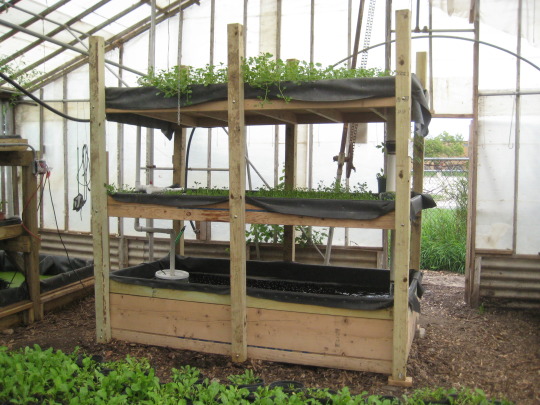
image source
A Truly Closed Loop? Consider the Food of the Fish!
When praising the sustainability of aquaponics, one thing that mustn't be ignored is the source of the fish food. Just like with the hydroponic systems, where the food for the plants or the fertilizer is considered, we can't ignore the feed we give to our fish to eat. If it is the same industrial feed, we may as well have kept to our hydroponics. Not true, since including fish already makes our system more diverse. So instead, let's continue in that same direction. What do fish eat? What is good for them? How can we grow that food ourselves?

image source
Making Your Own Sustainable Fish Food
Here I could probably start a number of individual posts, since talking about fish food is like opening up a can of worms. But fortunately, I already have a number of appropriate things written. Talking about worms, by the way, anyone who has been fishing knows that they are a favored delicacy, and anyone who composts will have no shortage of them. Since worms are mostly vegetarians, and many of us eat meat, it may have been a bit difficult to properly compost greasy, meaty, bony food wastes. That's where black soldier flies come in, whose larvae are also frequently mentioned for fish food. I still need to try growing those guys. As for green plants for the fish, duckweed makes also good fish feed, again something I have no experience with. What I do know, though, is spirulina, which is also super rich in nutrients, and I would be surprised if the fish didn't like it. So I can see throwing some composting worms, black soldier fly larvae, and spirulina into a blender, to make some great nutritious fish food. At the moment this is very theoretical for me, though.

image source
Don't Give Up the Soil Completely
So does this mean we should all focus on setting up our most sustainable fish-plant-compost combo cycles? Hells yeah! But please not at the expense of everything else! Soilless gardening, as exciting and revolutionary as it may sound, is still that: without soil. And let's face it: neither us, nor our beans and tomatoes, have evolved to live entirely without soil. That just seems wrong. Even in a small urban apartment it's worth having a bit of soil on your roof, balcony, or window sill, where you can dig your hands into a world of healthy microbial diversity on occasion. And if you do have the space, by all means, set up a pond, a dam, or another aquatic ecosystem, where fish, and frogs, and dragonflies, and numerous other species can live together without relying on our management. Apart from looking pretty, they will also provide food for us, that is nutritionally superior to anything industrially grown.
Sources: 1, 2, 3, 4, 5, 6, 7, 8
115 notes
·
View notes
Text
youtube
Explore 5 sustainable ecovillages and communities that are built on the premise of building a brighter future. See these locales that are built with focuses on permaculture, and other design techniques that you can use to make your home more friendly to nature and the Earth.
Crystal Waters: https://crystalwaters.org.au/
• Crystal Waters Ec...
Earthaven: https://www.earthaven.org/
• Frequency555.com:...
As of posting, I can no longer find the Decolonizing Permaculture event, but they do have a tag on decolonizing permaculture:
https://www.earthaven.org/tag/decolon...
Ecovillage at Ithaca: https://ecovillageithaca.org/
https://www.ic.org/directory/ecovilla...
Documentary: • 230 People LIVING...
Asociación Gaia https://gaia.org.ar/
• ¡Condominio Amane...
Findhorn Ecovillage: https://www.ecovillagefindhorn.com/
• The Findhorn Foun...
Global Ecovillage Network: https://ecovillage.org/
Tautumeitas: • Tautumeitas | Spo...
--------------------------------------------------------------
So often we see visions of a grim future, Solarpunk is a movement and sci-fi genre that pictures what the world would be like with a sustainable society built upon 100% renewable energy. I'm Lindsay Jane, and the Solarpunk Scene is my exploration of the expanding positive force that is changing the world. Check out my videos and the website to see what's going on, and I hope that you can join me on this journey of trying to save the future.
Website: thesolarpunkscene.wordpress.com
Instagram: www.instagram.com/thesolarpunkscene/
Facebook: https://www.facebook.com/thesolarpunk...
Patreon: https://www.patreon.com/user?u=48919268
#The Solarpunk Scene#solarpunk#eco village#sustainability#sustainable communities#permaculture#Crystal Waters#Earthaven#Ecovillage at Ithaca#Ithaca#Asociación Gaia#Findhorn Ecovillage#Global Ecovillage Network#Tautumeitas#Youtube
75 notes
·
View notes
Text
I love working with absolute geniuses in restoration. Like, this person knows what plants to plant to remove deadly diseases from water, that one over there understands the local area better than anyone, and everyone else understands the intersections of physics and biology and justice to a point where they could write phd dissertations if they weren't so busy doing applied restoration work.
But if there's a baby turtle on the job site, that's our WHOLE DAY
#everyone is such an outdoor dork its adorable#we had a flock(?) of ducks on a lake pull up to us and we exclaimed over their little duck butt feathers for a SOLID 15 mins#solarpunk#gardening#permaculture#sustainability#restoration#conservation#turtle
414 notes
·
View notes
Text

from the 'wholistic + abundant {lifestyle}' Pinterest board
#g#earth stewardship#eco#eco conscious#ecofeminism#holistic leveling up#leveling up#sustainability#that girl#green juice girl#wellness journey#solarpunk#mindful consumption#ethical consumption#slow living#soft living#permaculture#true being#self care#true nourishment#mindfulness#sidewalkchemistry
84 notes
·
View notes